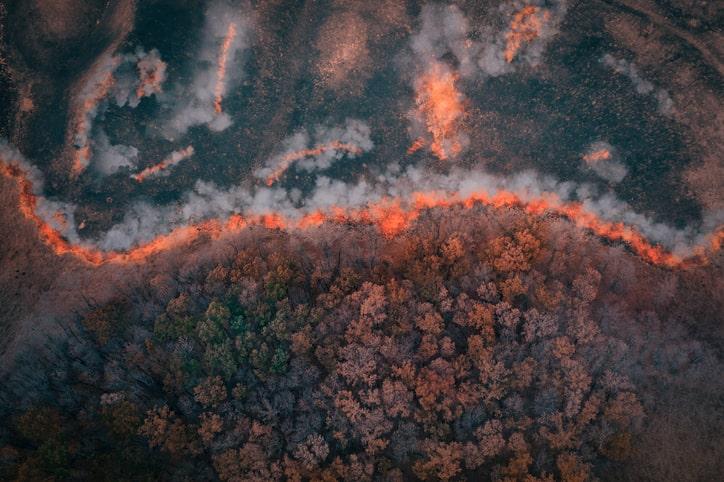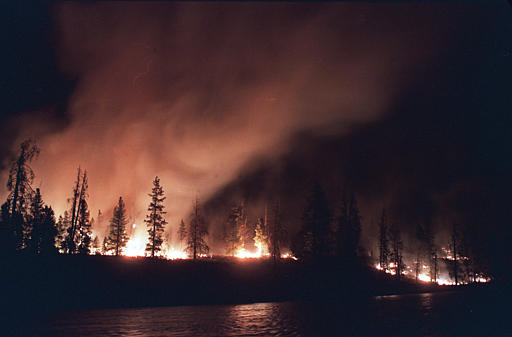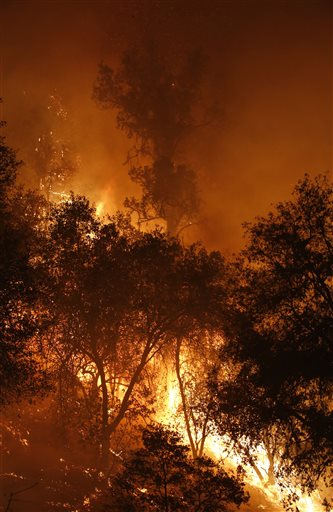Worst U.S. Forest Fires
Updated December 6, 2022 |
Infoplease Staff



Great Balls of Fire
- 1871
- Oct. 8-14, Peshtigo, Wis: over 1,500 lives lost and 3.8 million acres burned in nation's worst forest fire.
- 1889
- June 6, Seattle, Wash.: fire destroyed 64 acres of the city and killed 2 people. Damage was estimated at $15 million.
- 1894
- Sept. 1, Minn.: forest fires ravaged over 160,000 acres and destroyed 6 towns; 600 killed, including 413 in town of Hinckley.
- 1902
- Sept., Wash. and Ore.: Yacoult fire destroyed 1 million acres and left 38 dead.
- 1910
- Aug. 10, Idaho and Mont.: fires burned 3 million acres of woods and killed 85 people.
- 1918
- Oct. 13-15, Minn. and Wis.: forest fire struck towns in both states; 1,000 died, including 400 in town of Cloquet, Minn. About $1 million in losses.
- 1947
- Oct. 25-27, Maine: forest fire destroyed part of Bar Harbor and damaged Acadia National Park. In all, 205,678 acres burned and 16 lives were lost.
- 1949
- Aug. 5, Mann Gulch, Mont.: 12 smokejumpers-firefighters who parachuted near the fire-and 1 forest ranger died after being overtaken by a 200-ft wall of fire at the top of a gulch near Helena, Mont. Three smokejumpers survived.
- 1956
- Nov. 25, Calif.: fire destroyed 40,000 acres in Cleveland National Forest and caused 11 deaths.
- 1970
- Sept. 26, Laguna, Calif.: large-scale brush fire consumed 175,425 acres and 382 structures.
- 1988
- Aug.-Sept., western U.S.: fires destroyed over 1.2 million acres in Yellowstone National Park and damaged Alaska woodlands.

Fire burning through Yellowstone National Park, Sept., 1988
Source: AP Photo/Tannen Maury
- 1990
- June, Santa Barbara, Calif.: Painted Cave fire burned 4,900 acres and destroyed 641 structures.
- 1991
- Oct. 20-23, Oakland-Berkeley, Calif.: brush fire in drought-stricken area destroyed over 3,000 homes and apartments. At least 24 people died; damage estimated at $1.5 billion.
- 1994
- July 2-11, South Canyon, Colo.: relatively small fire (2,000 acres) led to deaths of 14 firefighters.
- 2000
- April-May, northern N.M.: prescribed fire started by National Park Service raged out of control, destroying 235 structures and forcing evacuation of more than 20,000 people. Blaze consumed an estimated 47,000 acres and threatened Los Alamos National Laboratory.
- Summer, western U.S.: as of Aug. 31 nearly 6.5 million acres had burned nationwide, more than double the ten-year average. States hardest hit included Alaska, Calif., Colo., Idaho, Mont., N.M., Nev., Ore., Tex., Utah, Wash., and Wyo.
- Spring-Summer, western U.S.: dry conditions led to one of the most destructive forest fire seasons in U.S. history. About 7.2 million acres burned nationwide, nearly double the 10-year average. States hardest hit included Alaska, Idaho, Mont., N.M., Nev., and Ore.
- 2002
- June-early July, mainly western U.S.: Hayman fire in Pike National Forest destroyed 137,760 acres and 600 structures, making it the worst wildfire in Colorado history. In central Ariz., the 85,000-acre Rodeo fire, which had already been declared the worst in Arizona's history, merged with the Chediski fire, destroying 468,638 acres and more than 400 structures. Large wildfires also burned in Alaska, southern Calif., N.M., Utah, Oregon, and Ga.
- 2003
- Oct. 25-29, southern Calif.: 15 devastating forest fires burned for two weeks, primarily in San Diego County, Ventura County, Riverside County, and San Bernardino County, forcing more than 80,000 people to evacuate their homes and burning 800,000 acres. More than 15,500 firefighters battled the blazes that killed 24 people and destroyed 3,640 homes. The Cedar Fire in San Diego, which burned through 200,000 acres, was the largest fire in California's history.
- 2004
- July-Aug., Alaska: wildfires in Alaska burned more than 5 million acres, the worst year for Alaska fires.
- 2006
- March 6-7, Texas: more than 200 wildfires in a 24-hour period destroyed 15 homes, killed 10,000 cattle and horses, and burned 191,000 acres. Since December 26th, Texas wildfires have killed 11 people, destroyed 400 homes, and burned more than 3.7 million acres.

Wildfire crosses U.S. Highway 70, near Pampa, Texas, March 2006
Source: AP Photo/Betsy Blaney
- 2007
- Oct. 21-25, southern Calif.: 16 wildfires from Simi Valley to the Mexican border were fanned by 50 to 60 mph winds and burned nearly 500,000 acres. Three people died, 25 firefighters and civilians were injured, and nearly 1,300 homes were destroyed. Over 500,000 people evacuated their homes while nearly 1,000 firefighters fought the flames.
- 2010
- September, Colo.: the Fourmile Canyon Fire burned 6,181 acres and destroyed 168 homes, becoming one of Colorado's most damaging fires.
- 2011
- Sept.–Oct., Texas: the Bastrop County Complex fire began as three separate fires that combined to create the worst conflagration in Texas history, destroying more than 32,000 acres, 1,700 homes and businesses, and killing 2.
- May–July, Ariz. and N.M.: the Wallow Fire consumed 538,049 acres at an estimated cost of $109 million. The largest single fire ever recorded in the lower 48 states,the Wallow Fire caused 14 injuries and damaged or destroyed more than 75 structures.
- 2012
- June–July, Waldo Canyon, Colo. a forest fire consumed 346 homes over 18,947 acres and forced the evacuation of more than 32,000 residents in one of Colorado's worst fires.
- May 9–July 23, Catron County, N.M. a wildfire burned through 297,845 acres of the Gila National Forest. More than 1,200 firefighters battled the wildfire, the largest in the state's history. The blaze started as two separate fires caused by lightning strikes, and they joined to form a massive blaze.
- June 9–July 23, Colo. about a dozen wildfires burned simultaneously, consuming more than 244,000 acres, destroying more than 600 homes, and causing six deaths. It was the worst year for wildfires in Colorado history. Military aircraft tankers were called in to help battle the flames.
- 2013
- June 30, Prescott, Ariz. 19 elite firefighters, part of the Granite Mountain Hotshots, were killed fighting the Yarnell Hill Fire. The wind suddenly changed direction, giving the firefighters little time to escape its path. The fire consumed 8,000 acres. It was the worst single loss of firefighters since the 2001 terrorist attacks.
- Aug. 17–Oct. 24, Yosemite National Park, California the third largest wildfire in California history, and the largest on record in the Sierra Nevada mountains, the Rim Fire burned through 257,314 acres.
- 2014
- July 14–Aug. 7, Okanogan County, Wash. the largest wildfire in the history of Washington state began when four separate fires were ignited by lightning strikes. The fire burned through 250,000 acres and destroyed an estimated 300 houses.

Fires burn near San Andreas, Calif., Sept. 2015
Source: AP Photo/Rich Pedroncelli
- 2015
- Sept., Calif. three major fires raged simultaneously. The Valley Fire burned through 73,000 acres in Lake and Napa Counties, killed one person, destroyed 600 houses, and forced thousands of people to evacuate. The Butte Fire burned in Amador and Calaveras Counties, destroyed more than 450 buildings and made its way through 70,000 acres. Meanwhile, the Rough Fire, the largest of the three fires, burned more than 140,000 acres and threatened to destroy some of the biggest and oldest trees in the world. Gov. Jerry Brown declared a state of emergency for Lake, Napa, Amador and Calaveras Counties.
- 2016
- May-Aug., California & Nevada after several years of drought, there were a huge number of dry and dead trees across the American Southwest. This led to a season where there were more than two dozen wildfires that burned for more than 1,000 ares. The worst was the Soberanes Fire that burned more than 132,100 acres and caused over a quarter billion dollars in damages.
- 2017
- Oct., Calif. Northern California suffered more than 250 fires, burning up to 250,000 acres of land and costing more than $12 billion dollars. The Diablo Winds (a phenomenon of high speed, dry, warm winds) carried the fires and led to many of the fires breaking out almost simultaneously. This was, at the time, the most devastating wildfire season in U.S. history.
- 2018
- Nov., Calif. among several other wildfires, California suffered its most devastating single fire in Butte County. The Camp Fire alone burned 153,000 acres, destroying nearly 19,000 buildings and killing 86 people. More than 52,000 people were evacuated ahead of the devastation. The fire was caused by a faulty electric wire. Two towns were effectively destroyed, with more than 95% of their buildings being destroyed. The total damages came to $16.5 billion, most suffered by uninsured residents. It was the sixth deadliest fire in U.S. history.
- The Woolsey Fire, that same month, burned another 96,000 acres near LA county. Although it was ultimately less destructive, it did prompt the evacuation of more than a quarter million California residents.
- 2020
- Aug., Calif. a major fire started in the Bay Area of California, identified as the SCU Lightning Complex. The fire complex is one of several across California, all in Northern California. The separate fires have affected well over 1 million acres of land in California, including large stretches of national forests. The fire complexes were all caused by lightning strikes across the area.
.com/ipa/0/7/7/8/6/8/A0778688.html
About the author







